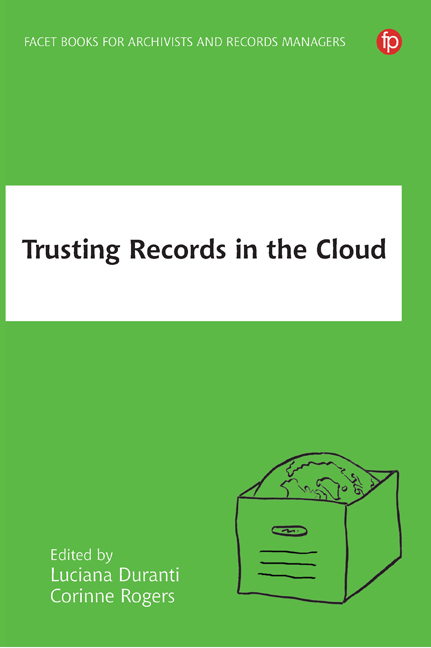Book contents
- Frontmatter
- Contents
- List of Figures and Tables
- Contributors
- 1 Introduction
- 2 The Cloud – Challenges and Issues
- 3 Open Government
- 4 Citizen Engagement
- 5 Strategies, Methods and Tools Enabling Records Governance in a Cloud Environment
- 6 Retention and Disposition
- 7 Authentication
- 8 Intellectual Control
- 9 Exploring Digital Preservation in the Cloud
- 10 Cultural Heritage – Indigenous Perspectives
- 11 The Role of the Records Professional
- 12 Education
- Appendix 1 InterPARES Trust Terminology
- Appendix 2 Products of InterPARES Trust Research
- Index
9 - Exploring Digital Preservation in the Cloud
Published online by Cambridge University Press: 24 September 2019
- Frontmatter
- Contents
- List of Figures and Tables
- Contributors
- 1 Introduction
- 2 The Cloud – Challenges and Issues
- 3 Open Government
- 4 Citizen Engagement
- 5 Strategies, Methods and Tools Enabling Records Governance in a Cloud Environment
- 6 Retention and Disposition
- 7 Authentication
- 8 Intellectual Control
- 9 Exploring Digital Preservation in the Cloud
- 10 Cultural Heritage – Indigenous Perspectives
- 11 The Role of the Records Professional
- 12 Education
- Appendix 1 InterPARES Trust Terminology
- Appendix 2 Products of InterPARES Trust Research
- Index
Summary
Introduction: an alternative to in-house digital preservation
Digital preservation initiatives and implementations have been in the past, and are still today, overwhelmingly in-house endeavours. In this paradigm, digital records that meet certain criteria are transferred from the creator to an archival repository, where professionals use in-house processes, facilities and software to ingest, process, transform (when deemed necessary), describe, store and secure archival information packages (AIPs) and disseminate renderings of digital records (DIPs) for use by researchers and other designated users. The software used is either developed and owned by the archives in question or is used under some kind of licencing arrangement (either commercial or open source). The preserved digital records are stored using (hopefully secure) in-house storage systems that may or may not have external network connections to the wider internet. In some cases, the AIPs may be stored entirely offline as ‘dark archives’, with suitably redacted and rendered DIPs accessible over the wider network via a search engine or discovery interface.
The in-house approach partly reflects the small, often ‘cottage industry’ scale of early digital preservation implementations, whereby archivists learn incrementally about digital preservation by doing it themselves on a small scale and gradually ramp up as expertise, resources, infrastructure and digital holdings expand over time. The approach also reflects a strong preference by professionals to have direct and total control of their archival holdings within the secure boundaries of their institutional repositories and infrastructure, reflecting the long tradition of archives as places of secure custody. There is a natural reluctance to trust this vital core business of archives, or part of it, to third parties.
The in-house approach, however, has some potential drawbacks. With digital preservation expertise still being somewhat scarce in the archival profession, in-house programmes sometimes struggle to develop and maintain a critical mass of the diverse archival and technical skillsets that are necessary to sustain a long-term digital preservation implementation. Very few such implementations have sought and received accreditation or benchmarking as ‘trustworthy digital repositories’. Arguably, therefore, some of these are deficient in one or more ways, and may indeed be blissfully unaware of their shortcomings.
- Type
- Chapter
- Information
- Trusting Records and Data in the Cloud , pp. 179 - 206Publisher: FacetPrint publication year: 2018



